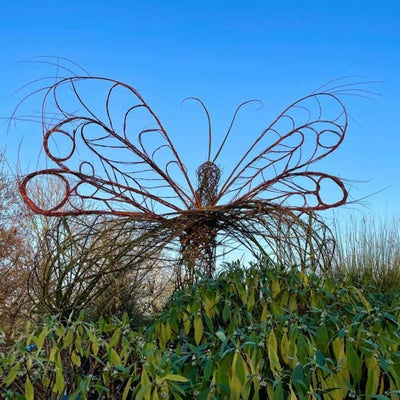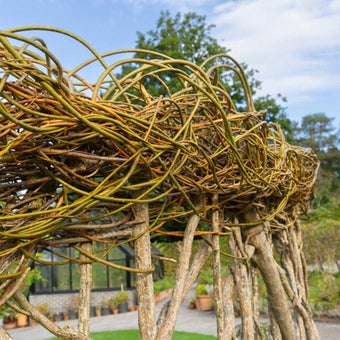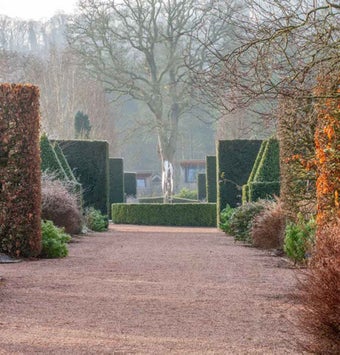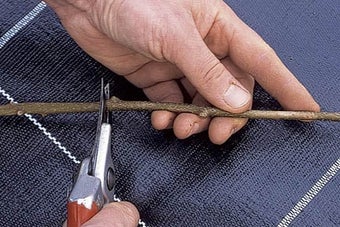
Quick facts
Suitable for - A range of colourful willow (Salix) species and cultivars
Timing - Plant from winter to early spring
Difficulty - Moderate
Suitable for...
Salix alba var. vitellina (golden willow), S. daphnoides, S. alba var. vitellina 'Britzensis', S. viminalis and S. purpurea are especially good for making living willow structures.
For the more adventurous, wigwams, chairs and sofas would be challenging projects. You can make garden rooms, create childrens’ play areas and provide privacy more quickly than with a more traditional hedge.
When to create your living willow structure
Winter to early spring is the best time to work on a project, particularly as specialist growers harvest the stems at this time of year.
How to make a fedge
A fedge is a cross between a fence and a hedge. It can be used as an informal boundary between areas of garden.
The raw material
- Specialist growers will supply mainly one-year-old rods or whips or staves (stems). These are fine, but if possible, order two-year-old material for uprights and one-year-old for the woven infill
- To help you chose the right height for your fedge, bear in mind that if you plant 2m (6½ft) rods 15-25cm (6-10in) deep at an angle of 45° the fedge will be about 1.2m (4ft) in height. Subsequent growth will easily double this height
- When your willow stems arrive, store them until needed in a dark cool place with the bases emersed in 10cm (4in) of water. Prune off the lower 10cm (4in) of stem when you plant, even if it has rooted when in contact with the water
Choosing the site
- Choose a part of the garden that is naturally moist and sunny, avoiding drains or buildings. Plant at least 10m (33ft) from these areas
- A moisture-retentive soil will encourage more vigorous growth although willow will grow in most soils
- Clear grass away from the base of the structure before planting and consider planting through a weed control membrane to eliminate the burden of weeding
- To keep down weeds once the willow is planted, apply a deep of composted or bark chippings around the rods
- Water the site thoroughly in dry spells
How to plant
- Make holes first with an old screwdriver or similar, then push the rods or whips (willow stems) 30cm (12in) or more into the ground
- Consider including four rods woven loosely together every 2m (6½ft) for solidity
- Plant half the rods at an angle of 45° at a distance of about 25cm (10in) apart
- Plant the remaining rods at a similar angle in between the first rods but in the opposite direction
- The stems may naturally graft together where the stems cross together. Encourage this by tying joins together with string or thin pieces of willow
- Shoots will sprout from the rods inserted into the ground. If cut back these new stems should help thicken the structure; useful if thin, one-year-old shoots were originally used to construct your feature
- For more elaborate weaving patterns and design ideas, specific books on the subject are available. Contact the library for details on Living Willow Sculpture by Jon Warnes (Search Press 2000, ISBN
0855328347)
Training
In winter, when shoots are pliable, weave in the new growth to fill gaps in the design or strengthen the structure, but avoid directing shoots downwards as they will die.
Pruning
- Willow can grow up to 2m (6½ft) per year, so you may need to trim several times during summer to keep the shape of the structure
- Trimming can be carried out in the summer and winter
Solid fedge
It is possible to make two sets of living willow hurdles and fill the gap with soil which makes a solid structure. Permanent irrigation would be necessary as one of the features of the structure is that the sides of the walls root into the soil, so would need a constant water supply. Construction is best carried out by specialist companies.
Problems
Rabbits and deer are partial to willow, so protection may well be necessary.
Willow aphids are brownish-black and may affect willow plants in late summer. Stems may become sticky and sooty mould may develop on this honeydew which the aphids produce. Use any aphid control product. Wasps may be attracted to honeydew, but if aphids are controlled wasps will not be a problem.
Willow anthracnose, scab and canker are fungal diseases that can affect Salix.



